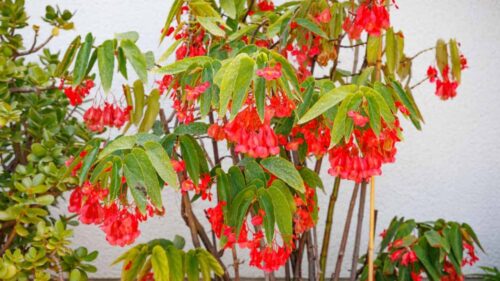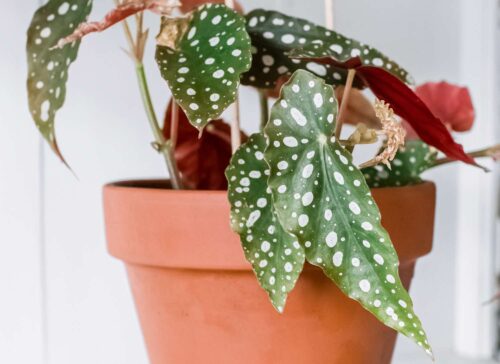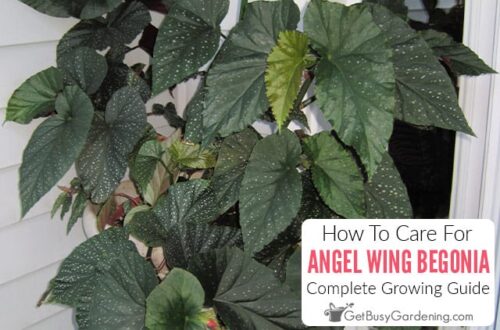Angel Wing Begonia care includes vibrant indirect mild, nicely-draining soil, regular watering, and excessive humidity. Propagate through stem cuttings in water or soil.
Common kinds are Begonia coccinea and Begonia aconitifolia. Provide warm temperature and much less watering throughout iciness. Angel Wing Begonias are beautiful and easy-to-care-for plants that are famous among indoor gardeners. With their particular foliage and vibrant colorings, they add a hint of beauty to any area.
In this guide, we will delve into the important care suggestions, propagation strategies, differing types, and iciness care recommendation for Angel Wing Begonias. Whether you’re a seasoned plant parent or a novice, you will find treasured information to ensure your Angel Wing Begonia prospers all 12 months spherical. Let’s explore the first rate world of Angel Wing Begonias collectively!

Caring For Angel Wing Begonia
Angel Wing Begonias are beautiful, delicate vegetation that require particular care to thrive indoors. Proper knowledge of critical aspects like watering, lights, temperature, and humidity is crucial for making sure their fitness and vitality. By following these tips, you can create an appropriate surroundings to keep your Angel Wing Begonia flourishing and lovely yr-spherical.
Watering
Angel Wing Begonias choose slightly wet soil but despise being waterlogged. It’s crucial to strike a balance, making sure the soil would not dry out absolutely between waterings. A preferred rule of thumb is to water the plant as soon as the top inch of soil feels dry to touch. Always make sure proper drainage inside the pot to prevent water accumulation.
Lighting
These begonias thrive in vivid, oblique mild, making them perfect for positioning close to a north or east-going through window. Excessive direct sunlight can scorch their delicate leaves, so it is crucial to defend them from harsh rays. Consider the usage of sheer curtains to clear out the mild and defend the plant from direct publicity.
Temperature
Consistent temperatures between 65-seventy five°F (18-24°C) match Angel Wing Begonias first-class. Avoid exposing them to unexpected temperature fluctuations, drafts, or severe warmness as it can reason pressure and damage to the plant. Maintaining a solid environment promotes healthful boom and colourful foliage.
Humidity
These begonias thrive in humid conditions, making them remarkable applicants for toilets or kitchens with better moisture stages. Misting the foliage often or placing a humidifier nearby can also help hold the specified humidity ranges. It’s important to save you the air around them from becoming excessively dry, which could cause leaf problems.

Propagating Angel Wing Begonia
Angel Wing Begonias may be without problems propagated through stem cuttings, leaf cuttings, or department.
Stem Cuttings
1. Cut a wholesome stem with as a minimum nodes using sharp, sterilized scissors.
2. Remove the decrease leaves and dip the reduce lead to a rooting hormone.
3. Plant the cutting in a properly-draining potting mix and maintain it wet but no longer soggy.
Leaf Cuttings
1. Select a healthful leaf and reduce it into sections, ensuring every piece has a vein.
2. Place the leaf sections on a moist, soilless blend and cover them lightly with plastic to keep moisture.
three. Keep the soil always wet and in indirect light until roots broaden.
Division
1. Carefully dispose of the Angel Wing Begonia from its pot and gently separate the roots into sections.
2. Plant every divided segment into a new pot with clean potting soil.
three. Keep the newly potted divisions in a warm, humid environment to sell increase.
Types Of Angel Wing Begonia
Angel Wing Begonia is available in numerous sorts, every with particular characteristics that cause them to applicable additions to any indoor plant series.
Angel Wing Begonia ‘lucerna’
This kind of Angel Wing Begonia is known for its sensitive, elongated leaves and colourful crimson flora.
Angel Wing Begonia ‘dragon Wing’
The ‘Dragon Wing’ Angel Wing Begonia sticks out with its sleek, dragon-like leaves and brilliant red blooms.
Angel Wing Begonia ‘sophie Cecile’
‘Sophie Cecile’ Angel Wing Begonia features bronze-inexperienced leaves with putting silver markings, including beauty to any space.
Angel Wing Begonia ‘mary Schwartz’
With its extensive, silver-noticed leaves and cascading increase habit, ‘Mary Schwartz’ Angel Wing Begonia is a captivating choice for putting baskets.
When being concerned for Angel Wing Begonias, make sure they receive vibrant, indirect light and always moist soil. Prune them often to promote hairy boom and do away with any leggy stems.
Common Problems And Solutions
Discover how to take care of Angel Wing Begonia flora, along with propagation tips, different sorts, and advice for the wintry weather season. Learn about not unusual troubles and powerful answers to hold your plants wholesome and thriving. Our comprehensive guide offers expert advice for each element of Angel Wing Begonia care.
The Angel Wing Begonia is a lovely and sensitive plant, but like any houseplants, it may come upon some common problems. Understanding those troubles and their answers will assist you hold a healthful and colourful begonia in your private home. Below are a few solutions to not unusual troubles you could come upon whilst caring on your Angel Wing Begonia.
Yellowing Leaves
Yellowing leaves in your Angel Wing Begonia can be a sign of overwatering, nutrient deficiencies, or inadequate light. Ensure the plant isn’t always sitting in water and adjust your watering agenda as a result. Providing a balanced fertilizer also can assist address nutrient deficiencies. Consider transferring the plant to a brighter vicinity to enhance its mild exposure.
Root Rot
Root rot is a common problem with Angel Wing Begonias, generally because of overwatering or negative drainage. To solve this hassle, allow the soil to dry out among waterings and ensure that the pot has adequate drainage. Trimming away any tender or discolored roots also can assist the plant recover from root rot.
Lack Of Blooms
If your begonia is not generating blooms, it can be due to inadequate mild or nutrients. Increasing the plant’s publicity to oblique sunlight and supplying a balanced fertilizer can inspire blooming. Additionally, deadheading spent plants and making sure appropriate humidity ranges can promote a healthy blooming cycle.
By addressing these commonplace issues proactively, you could make sure that your Angel Wing Begonia stays vibrant and flourishing at some point of the 12 months. Keeping a near eye on your plant’s health and making modifications as wished will assist you cultivate a thriving and beautiful begonia in your private home.
Winter Care Tips
During the iciness months, it is crucial to present your Angel Wing Begonia the greater care it wishes to thrive. The bloodless and dry situations of wintry weather may be challenging for this tropical plant, however with the proper care, you could make sure its health and splendor throughout the season. In this section, we will discuss 3 vital aspects of winter take care of your Angel Wing Begonia: Reducing Watering, Adjusting Light Levels, and Providing Adequate Humidity.
Reducing Watering
A important issue of worrying to your Angel Wing Begonia in iciness is to lessen watering. The plant’s increase slows down throughout this period, and overwatering can result in root rot and different problems. To save you this, constantly allow the top few inches of soil to dry out before watering. Check the moisture degree using your finger or a moisture meter. In winter, it’s satisfactory to water your Begonia simplest while the soil feels barely dry, approximately an inch below the floor. Be cautious now not to permit the soil become bone dry, as it can motive stress to the plant.
Adjusting Light Levels
Another important attention for winter care is adjusting the mild levels for your Angel Wing Begonia. While those plants experience shiny, oblique light, they may be touchy to direct daylight, mainly in the course of the winter months. Place your Begonia in a region wherein it gets bright but filtered mild in the course of the day. Avoid exposing it to harsh afternoon sun, as it can scorch the leaves. Consider the use of sheer curtains or blinds to shield the plant from excessive sunlight. If you be aware your Begonia stretching closer to the mild supply, it can be an illustration that it desires greater light.
Providing Adequate Humidity
Humidity is important for the fitness of your Angel Wing Begonia, especially throughout the dry wintry weather months. The best humidity degree for those flowers is around 50-60%. To provide adequate humidity, you can use a humidifier close to the plant or create a pebble tray by using filling a tray with water and putting your potted Begonia on pinnacle. As the water evaporates, it will increase the humidity across the plant. Alternatively, you can group numerous houseplants collectively, with a view to help create a microclimate with improved humidity. Avoid putting your Begonia near drafts or heating vents, as they are able to motive dry air and coffee humidity.

Pests And Disease Control
Learn effective methods for handling pests and diseases while being concerned for Angel Wing Begonias. Discover tips for propagation, various kinds, and important winter care recommendation to maintain plant health. Expert guidance guarantees your Begonias thrive indoors and exterior all year round.
Aphids
One not unusual pest that may affect Angel Wing Begonias are aphids. These small, tender-bodied insects feed on the sap of flora, inflicting them to weaken and become less healthful. If left unchecked, aphids can quick multiply and infest your begonias. Fortunately, there are numerous simple strategies to control their populace and prevent damage:
- Manual removal: Carefully investigate your flowers for clusters of aphids and gently eliminate them by hand. This may be carried out by using the use of a moist cloth or cotton swab to wipe away the pests.
- Natural predators: Encouraging beneficial insects, consisting of ladybugs and lacewings, can help manage aphid populations. These bugs are herbal predators and will feed on the aphids, keeping their numbers in check.
- Natural remedies: Spraying a solution of soapy water or neem oil onto the affected regions can efficiently deter aphids. These materials smother the pests and disrupt their feeding, assisting to defend your begonias.
- Chemical manage: In severe instances, you could want to lodge to chemical pesticides. However, it’s critical to apply these merchandise sparingly and consistent with the commands, as they could damage beneficial insects and other natural world.
Spider Mites
Another commonplace pest which can problem Angel Wing Begonias are spider mites. These tiny pests are barely visible to the naked eye but can cause significant harm on your plant life. Spider mites suck the sap out of leaves, inflicting them to show yellow and develop a stippled appearance. To save you the infestation or manipulate their population, observe these steps:
- Regular monitoring: Inspect your flora frequently for signs of spider mites. Look for tiny webs, discolored leaves, or a dusty appearance on the undersides of the leaves.
- Water spray: A strong blast of water can help dislodge spider mites out of your begonias. Aim the water on the affected regions, making sure you attain the undersides of the leaves.
- Oil-based totally sprays: Applying neem oil or horticultural oil in your plant life can smother spider mites and prevent further infestation. Make certain to cowl the complete plant, along with the undersides of leaves.
- Biological control: Introducing predatory mites, inclusive of Phytoseiulus persimilis, can assist manage spider mite populations. These mites feed on their pest counterparts and may cast off them from your flowers.
Botrytis Blight
Botrytis blight is a commonplace fungal disorder that may have an effect on Angel Wing Begonias, particularly in humid or poorly ventilated situations. This sickness reasons grey or brown patches on leaves, stems, and plants, eventually main to their decay. To prevent or manage Botrytis blight, consider the subsequent techniques:
- Avoid overhead watering: Water your begonias at the bottom to decrease leaf wetness, as the fungus prospers in moisture.
- Provide suitable air flow: Ensure right spacing among flowers and prune any overcrowded areas to sell airflow and reduce humidity degrees.
- Cleanliness is prime: Regularly dispose of fallen leaves and other plant particles from the encompassing region to save you the unfold of fungus.
- Fungicidal treatments: If Botrytis blight is already present, horticultural fungicides can help in controlling its spread. Apply those remedies according to the product instructions and avoid excessive use to prevent resistance from developing.
Frequently Asked Questions For Angel Wing Begonia – How To Care, Propagation, Types, Winter Advice
How Do I Care For An Angel Wing Begonia?
Angel Wing Begonias thrive in properly-draining soil, vivid oblique mild, and slight humidity. Water whilst the top inch of soil is dry and feed with a balanced fertilizer throughout the developing season. Keep faraway from drafts and shield from direct daylight.
What Are The Different Types Of Angel Wing Begonias?
There are several forms of Angel Wing Begonias, which include Begonia ‘Lucerna’ with silver leaves, Begonia ‘Black Pagoda’ with darkish foliage, and Begonia ‘Gryphon’ with putting styles. Each range offers precise colorations and leaf shapes to enhance your garden.
How Do I Propagate An Angel Wing Begonia?
Propagating Angel Wing Begonias may be carried out thru stem cuttings. Simply snip a healthful stem beneath a node and area it in wet soil or water until roots broaden. Once installed, switch the cutting to a pot with properly-draining soil.
Can Angel Wing Begonias Tolerate Winter Conditions?
While Angel Wing Begonias are normally grown indoors, they are able to tolerate cooler temperatures at some point of iciness. Provide them with vibrant indirect light, reduce watering frequency, and hold them far from cold drafts to make certain their finest growth and survival.
Conclusion
Angel Wing Begonias are charming and relatively low-protection flora that can liven up any indoor space. With the proper care and attention, they can thrive and bloom superbly. Whether you prefer the cane or shrub varieties, those lovely vegetation are a satisfying addition to any collection.
Happy gardening!
